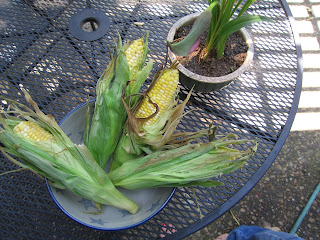
Dear readers, I am sorry.
Honestly, for my non-Germany-based readers, you really should be kicking yourselves for not being in The Land of Many Bakeries. If you could only see the endlessly delicious street corners, the bakeries filled with treats of all shapes, creams and custards and glazed fruits and chocolate. Oh, the chocolate. The best thing about it all is that everyone here loves sweets. We all know how positively annoying it is to be in a place where you feel like the lone non-dieter, the only person who really, really must have a treat at least once a day. When you feel like the Santa Claus on Christmas Eve compared to the stick-thin rabbits surrounding you? Well, you will never, ever feel that way in Germany. Bring on the butter and sugar, folks, we're having a party! Or maybe not a party, we just need a little mid-morning pick-me-up. That's the spirit.

I've tried to be responsible to my stomach, but thus far, I've tasted Mohnschnecke, Apfelkuchen, Macarons (yes, I know that they are French), hazelnut ice cream, raspberry ice cream, butter cookies, almond croissants, Ritter Sport chocolate, cappuccino-flavored chocolate, waffle cookies, rhubarb squares - what, not stomach-conscious you say? What about the Sephardic orange cake? That's healthy, right?
I'm dying to make a few of these recipes. Unfortunately, as I've mentioned a few (too many) times, I'm a bit short on baking hours so you can expect plenty of experimentation mid-September. For now let's begin with a few words on this pictured Apfelkuchen. What you see here is the most typical German apple cake. It's baked in a sheet and cut into large rectangles. The bottom layer is a light yellow cake - thicker than pound but heavier than angel food. Second, there's a creamy layer, topped with thinly sliced peeled apples. Last, you've got crumbly streusel to round out the cake's textural variation. When I first purchased this cake, I had the option of buying it with a glazed top in place of the streusel, but my hitherto unacknowledged streusel affinity won out, and I succumbed to buttery bliss.
My second thought, after the streusel vs. glaze debate, was that the cake layer was too thick compared to the custard-cream layer. I might have thought differently had the cake been of the thicker pound variety, but this cake looked like it only functioned as a serving platter for the cream. Bite number one, however, proved to me that I judged too soon. The cream is shockingly sweet - thick and milky, and in fact, it needs to be cut by the light texture of the cake. The streusel gives the whole cake a necessary crunch, making each bite a play of moist and dry, slippery and chewable, buttery and fruity.

I offer two primary suggestions for this pastry. Most importantly, the thickness of both apples and streusel layers should be increased, as both were slightly overwhelmed by the cream. Next, the butter content in the streusel should also be upped. When I test an apfelkuchen recipe in September, I'll make sure to create a cake with slightly better ratios. On the other hand, I'm sure that the apple cake recipes vary from bakery to bakery here.
Besides this complaint, all I can really say is that oh my, do Germans know their pastries.

Oh, and to those of you who are celebrating Tish'a b'Av, hurry and buy your cake before the fast begins!























